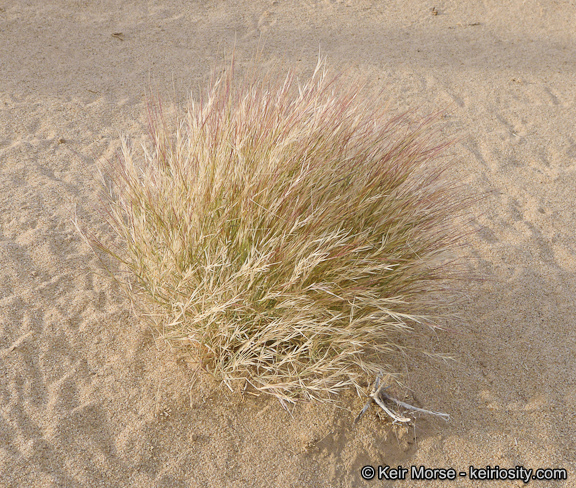Plants perennial; sometimes flowering the first year. Culms 10-40 cm, highly branched above the base in age; internodes glabrous or pubescent, sometimes nearly lanose. Leaves cauline; sheaths shorter than the internodes, glabrous or puberulent; collars glabrous or pubescent at the sides; ligules 0.5-1 mm; blades usually less than 6 cm long, 0.5-1 mm wide, pale green, involute, glabrous or puberulent abaxially. Inflorescences paniculate or racemose, 5-10 cm long, 1-2 cm wide, with few spikelets; rachis nodes glabrous or with straight hairs; primary branches 1-2 cm, appressed, without axillary pulvini. Spikelets appressed. Glumes unequal, 1-2-veined; lower glumes 4-10 mm; upper glumes 7-15 mm; calluses about 1 mm; lemmas 5-7 mm, purple or mottled, junction of the lemma and awns evident; awns twisted together basally into a 4-26 mm column, free portions 12-50 mm, those of the central and lateral awns similar in length, curved to arcuate basally, straight and divergent distally, disarticulating at the base of the column at maturity; anthers 3, about 2 mm long. 2n = 22.
The range of both varieties of A. californica extends from the southwestern United States into northwestern Mexico.
Common Name: California threeawn
Duration: Perennial
Nativity: Native
Lifeform: Graminoid
General: Tufted perennial, looks like an annual, with wiry stems 10-40 cm, highly branched above the base in age, with glabrous to pubescent or nearly woolly internodes, sheaths shorter than internodes, collars glabrous or pubescent at sides.
Vegetative: Blades usually less than 6 cm long, 0.5-1 mm wide, pale green, involute, glabrous to puberulent below, ligule a crown of short hairs, 0.5-1 mm.
Inflorescence: Short few flowered panicle or racemose, 5-10 cm long, 1-2 cm wide; few spikelets, appressed with unequal glumes, 1-2 veined, lower 4-10 mm, upper 7-15 mm, lemmas 5-7 mm, purple or mottled with the junction of the awns and lemma evident; awns twisted together basally into a 4-26 mm column, free portions 12-50 mm, central and lateral awns generally the same length, curved to arcuate basally, straight or divergent above, disarticulating at the base of the column at maturity.
Ecology: Found in dry soils, especially gravelly or sandy soils from 2,000-5,000 ft (610-1524 m); flowers March-October.
Notes: In the region there are two varieties: var. californica and var. glabrata. The former is distinguished by the cauline internodes being puberulent to nearly woolly. The latter has cauline internodes that are glabrous.
Ethnobotany: Unknown
Etymology: Aristida is from the Latin arista for awn, while californica means of or from California.
Synonyms: Aristida californica var. fugitiva, A. californica var. major, A. fugitiva, A. jonesii, A. peninsularis
Editor: SBuckley, 2010











